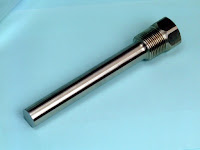A blog providing information about industrial temperature measurement, specifically in the areas of temperature sensors. The posts will contain educational information about thermocouples, RTDs, and other common types of temperature sensors. The application of these sensors will focus on aerospace, aircraft, research and development, medical, chemical, plastics processing, and power generation industries. For more, visit Duro-Sense.com or call 310-533-6877.
Sunday, September 23, 2018
Monday, September 10, 2018
Thermowells
 |
| Thermowell (Duro-Sense) |
Thermowells may be made out of any material that is thermally conductive, pressure-tight, and not chemically reactive with the process. Most thermowells are formed out of either metal (stainless steel or other alloy) or ceramic materials. A simple diagram showing a thermowell in use with a temperature sensor (RTD) is shown here:
As useful as thermowells are, they are not without their caveats. All thermowells, no matter how well they may be installed, increase the first-order time lag of the temperature sensor by virtue of their mass and specific heat value. It should be intuitively obvious that a few pounds of metal will not heat up and cool down as fast as a few ounces’ worth of RTD or thermocouple, and therefore the addition of a thermowell to the sensing element will decrease the responsiveness of any temperature- sensing element. What is not so obvious is that such time lags, if severe enough, may compromise the stability of feedback control. A control system receiving a “delayed” temperature measurement will not see the live temperature of the process in real time due to this lag.
 |
| RTD with Thermowell |
Reprinted from Lessons In Industrial Instrumentation by Tony R. Kuphaldt – under the terms and conditions of the Creative Commons Attribution 4.0 International Public License.
Tuesday, August 28, 2018
Temperature Transmitters
 |
| Temperature Transmitters (Duro-Sense) |
Analog Transmitters: These transmitters are designed on analog circuit technology. They normally offer basic functions such as temperature linearization and sensor break technology. Sometimes they are adjustable for different measuring ranges, often with a fast response time.
Digital Transmitters: This transmitter type is mainly based on a microprocessor. They are often called intelligent transmitters, because they normally offer many extra features, which are not possible to realize in analog transmitters.
In-Head Transmitters: These transmitters are designed for mounting in the connection heads of temperature sensors. All Duro-Sense in-head transmitters fit into DIN B heads or larger. Special care has to be devoted to the ruggedness because of the harsh conditions that sometimes exist.
DIN Rail Transmitters: DIN rail transmitters are designed to be snapped onto a DIN rail. Duro-Sense DIN rail transmitters fit on a 35mm rail according to DIN EN 50022.
RTD Transmitters: RTD transmitters are used only for RTD sensors. (Pt100, Pt1000, Ni100, etc.). Normally they can handle only one RTD type. Most Duro-Sense transmitters can handle more than one type of RTD and are either fix- ranged or adjustable. They all have linear output.
Analog Output: The output signal is a current (4-20mA). Some transmitters are available with 0-20mA or 0-10mA output. The signal is normally proportional to the measured value within a defined measurement range.
Digital Output: The measured value (temperature) is presented as a binary coded message. So called Fieldbus transmitters use this technique. The Fieldbus transmitters on the market today use different standards for the communication thus creating some problems when integrating them with other instrumentation. Examples of standard available are: PROFIBUS, Interbus, Foundation Fieldbus, LonWorks and CAN-bus.
Analog and Digital Output: The HART transmitters have an analog output with a superimposed digital signal on the same wires. Typically, the analog signal is used for normal measurements and the digital signal only for temporary measurements, because of the low communication speed. The digital signal is mainly used for configuration and status information.
Isolated Transmitters: Isolated transmitters have no leading connections between circuits that are isolated from each other. The isolation effectively eliminates the risk for circulating currents and facilitates the connection of transmitters to control systems with grounded inputs.
Non-Isolated Transmitters: These transmitters have leading connections between, for instance, input and output circuits. They should be used with care.
For more information on temperature transmitters, visit https://duro-sense.com or call 310-533-6877.
Friday, August 17, 2018
Temperature Sensors for the Toughest Applications
 |
| Click for larger view. |
All Duro-Sense customers benefit from years of tackling difficult applications. By implementing stringent quality practices and advanced manufacturing processes, Duro-Sense continues to solve the most challenging temperature sensing applications.
Duro-Sense is a one-stop, full service provider of anything related to temperature sensing. Service. Quality. On-time delivery.
Rely on the Duro-Sense difference.
www.duro-sense.com | 310-533-6877.
Friday, August 3, 2018
Video: Comparison of Thermocouples and RTDs
The video below describes the basic differences between industrial thermocouples and RTDs.
Duro-Sense Corporation provides the thermocouples, RTDs, thermowells, and accessories to the aerospace, aviation, process control, medical, R&D, power generation, alternative energy, plastics, primary metals, high-tech and OEM industries.
https://duro-sense.com
310-533-6877
Duro-Sense Corporation provides the thermocouples, RTDs, thermowells, and accessories to the aerospace, aviation, process control, medical, R&D, power generation, alternative energy, plastics, primary metals, high-tech and OEM industries.
https://duro-sense.com
310-533-6877
Wednesday, July 18, 2018
Reliable, Robust, and Affordable Process Heating Sensors and Controls
The ability to effectively measure, monitor, and control process heating operations is essential to minimize product variability and maintain product quality. This level of control requires reliable and affordable sensors and control systems that can withstand harsh environments and not require recalibration for at least one year. Process heating could become far more effective with access to more reliable, robust, and affordable sensors and process controls. There is a need for reliable, cost effective sensors for harsh environments and for the real-time measurement of the chemical composition of the fuel, oxidant, and flue gas in combustion processes. Real-time combustion controls for multiple fuel applications could help maximize fuel flexibility, while improved sensors as part of smart control systems could increase efficiency, safety, and reliability. In electromagnetic processes, low cost, robust, and reliable sensors are needed to measure field strength, as well as sensors that can measure process parameters but are immune to direct excitation by the electromagnetic energy.
 Technology opportunities for sensors and process controls to improve the overall control and
Technology opportunities for sensors and process controls to improve the overall control and
performance of process heating systems include the following:
Sensors for Harsh, High-Temperature Environments: Technologies and methods are needed to reliably monitor and control critical product parameters (temperature, chemistry, pressure, etc.), especially robust sensors to measure critical parameters in harsh combustion environments. This includes direct process measurement sensors, and more accurate and reliable thermocouples and other sensors. The development of sensors that can provide accurate readings in high-temperature environments could enable opportunities to optimize heat transfer and containment systems in those conditions.
Furnace Control: In fuel-fired equipment, reliable sensing and control technologies can provide better fuel utilization, energy savings, temperature control, and system performance over time. This includes sensors that can accurately measure compositional characteristics of fuels and oxidant; low-cost, highly reliable flame monitoring systems to control flame quality and stability; and continuous flue gas analysis. By regulating and stabilizing internal furnace pressure, pressure controllers can eliminate cold air infiltration, maintain uniform temperatures, and reduce wear that would require more frequent and costly maintenance.
Advanced Control Strategies to Optimize Process Heating: Cost-effective smart process controls that can be integrated with the overall manufacturing system are needed. Analysis of flue gases can be used to optimize the inlet fuel/air ratio. By using sensors to measure oxygen and carbon monoxide in the flue gas stream, conditions can be created for ideal combustion scenarios.
 Technology opportunities for sensors and process controls to improve the overall control and
Technology opportunities for sensors and process controls to improve the overall control and performance of process heating systems include the following:
Sensors for Harsh, High-Temperature Environments: Technologies and methods are needed to reliably monitor and control critical product parameters (temperature, chemistry, pressure, etc.), especially robust sensors to measure critical parameters in harsh combustion environments. This includes direct process measurement sensors, and more accurate and reliable thermocouples and other sensors. The development of sensors that can provide accurate readings in high-temperature environments could enable opportunities to optimize heat transfer and containment systems in those conditions.
Furnace Control: In fuel-fired equipment, reliable sensing and control technologies can provide better fuel utilization, energy savings, temperature control, and system performance over time. This includes sensors that can accurately measure compositional characteristics of fuels and oxidant; low-cost, highly reliable flame monitoring systems to control flame quality and stability; and continuous flue gas analysis. By regulating and stabilizing internal furnace pressure, pressure controllers can eliminate cold air infiltration, maintain uniform temperatures, and reduce wear that would require more frequent and costly maintenance.
Advanced Control Strategies to Optimize Process Heating: Cost-effective smart process controls that can be integrated with the overall manufacturing system are needed. Analysis of flue gases can be used to optimize the inlet fuel/air ratio. By using sensors to measure oxygen and carbon monoxide in the flue gas stream, conditions can be created for ideal combustion scenarios.
Friday, July 6, 2018
Common Terminology Used in Temperature Measurement and Process Control
Accuracy: The closeness of an indicator or reading of a measurement device to the actual value of the quantity being measured; usually expressed as ± percent of the full scale output or reading.
Drift: The change in output or set point value over long periods of time due to such factors as temperature, voltage, and time.
Hysteresis: The difference in output after a full cycle in which the input value approaches the reference point (conditions) with increasing, then decreasing values or vice versa; it is measured by decreasing the input to one extreme (minimum or maximum value), then to the other extreme, then returning the input to the reference (starting) value.
Linearity: How closely the output of a sensor approximates a straight line when the applied input is linear.
Noise: An unwanted electrical interference on signal wires.
Nonlinearity: The difference between the actual deflection curve of a unit and a straight line drawn between the upper and lower range terminal values of the deflection, expressed as a percentage of full range deflection.
Precision: The degree of agreement between a number of independent observations of the same physical quantity obtained under the same conditions.
Repeatability: The ability of a sensor to reproduce output readings when the same input value is applied to it consecutively under the same conditions.
Resolution: The smallest detectable increment of measurement.
RTD: Abbreviation for "resistance temperature detector". Resistance temperature detectors are temperature sensors that are widely used because of their high accuracy, stability, and linearity. They work on the principle that the resistivity of metals is dependent upon temperature; as temperature increases, resistance increases. Resistance Temperature Detector’s can withstand temperatures up to approximately 800 C (~1500 F).
Sensitivity: The minimum change in input signal to which an instrument can respond. Stability: The ability of an instrument to provide consistent output over an extended
period during which a constant input is applied.
Thermocouple: A temperature sensing device widely used because they are relatively low cost, self-powered, durable and capable sensing high temperatures. Thermocouples generate and micro voltage in relation to temperature change.
Zero balance: The ability of the transducer to output a value of zero at the electronic null
point.
Drift: The change in output or set point value over long periods of time due to such factors as temperature, voltage, and time.
Hysteresis: The difference in output after a full cycle in which the input value approaches the reference point (conditions) with increasing, then decreasing values or vice versa; it is measured by decreasing the input to one extreme (minimum or maximum value), then to the other extreme, then returning the input to the reference (starting) value.
Linearity: How closely the output of a sensor approximates a straight line when the applied input is linear.
Noise: An unwanted electrical interference on signal wires.
Nonlinearity: The difference between the actual deflection curve of a unit and a straight line drawn between the upper and lower range terminal values of the deflection, expressed as a percentage of full range deflection.
Precision: The degree of agreement between a number of independent observations of the same physical quantity obtained under the same conditions.
Repeatability: The ability of a sensor to reproduce output readings when the same input value is applied to it consecutively under the same conditions.
Resolution: The smallest detectable increment of measurement.
RTD: Abbreviation for "resistance temperature detector". Resistance temperature detectors are temperature sensors that are widely used because of their high accuracy, stability, and linearity. They work on the principle that the resistivity of metals is dependent upon temperature; as temperature increases, resistance increases. Resistance Temperature Detector’s can withstand temperatures up to approximately 800 C (~1500 F).
Sensitivity: The minimum change in input signal to which an instrument can respond. Stability: The ability of an instrument to provide consistent output over an extended
period during which a constant input is applied.
Thermocouple: A temperature sensing device widely used because they are relatively low cost, self-powered, durable and capable sensing high temperatures. Thermocouples generate and micro voltage in relation to temperature change.
Zero balance: The ability of the transducer to output a value of zero at the electronic null
point.
Subscribe to:
Comments (Atom)


